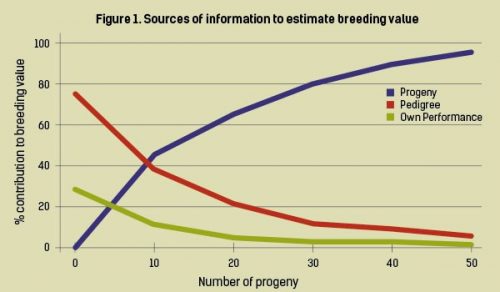Understanding Estimated Breeding Values
Animal breeding is based on selection, which is based on genetics. With good information about the animal’s genetics, you can make better selection decisions and improve the breed faster. In the absence of genetic tests for complex inherited disorders like hip and elbow dysplasia, phenotypic selection based on hip and elbow scores has proven to be somewhat effective. Incorporation of estimated breeding values (EBVs) into these selection schemes should accelerate advances in hip and elbow improvement.
Estimated breeding values (EBVs) are the value of an individual as a genetic parent. The lower the heritability of a trait under selection, the slower the herd will improve. A trait that is 60% heritable, means that 60% of the difference between animals is due to genetics (the EBVs), while the remaining 40% is due to the difference in management and environment.
EBVs enable you to compare individuals of the same breed from different kennels. They are expressed as a unit of measurement and published with a confidence value (%). EBVs can change as new information is analysed. EBVs are not hip scores; this info is not telling you that a dog has better hips than another dog; it’s telling you that a dog has better GENES for hips than another dog. Even a dog with a hip score above breed average might have a good EBV. Using EBVs will lower the incidience of hip dysplasia and better preseves the genetic diversity of our breed. To estimate breeding values for hip and elbow data, you need to know: the dog’s own hip and elbow score, pedigree data and progeny data.
As seen in Figure 1, if the individual has no progeny, its records contribute less to the EBV than the pedigree records. As its progeny increases, the contribution to the individual’s breeding value will increase and the contribution of the individual and the pedigree will decrease.
Confidence
When estimating the breeding value for an individual, remember that the sire and dam each contribute half of their EBV to their progeny. For example, Sire A has a breeding value of -10 for hip dysplasia, while Dam A has a breeding value of +10 for hip dysplasia.
The sire contributes half, which is -5, and the dam +5, so their progeny will have an EBV of 0 the breed average. The confidence of a breeding value is the difference between the true breeding values and the expected breeding values. Confidence (%) is based on the amount of data available on the animal and its close relatives, particularly the number of progeny.
The heritability of the trait and the genetic correlations with other recorded traits are also important. Confidence is an indicator of a breeding value’s reliability and the risk entailed when a specific trait is selected. Confidence is measured in % (see Table 1).
Table1. Confidence of breeding values |
|
| Confidence range | Interpretation |
| < 50% | Low accuracy. EBVs are preliminary and could change substantially as more information becomes available. |
| 50-74% | Medium accuracy, usually based on the animal’s own records and pedigree. |
| 75-90% | Medium-high accuracy. Some progeny information included. EBVs may change with addition of more progeny data. |
| > 90% | High accuracy estimate of the animal’s true breeding value. |
If an animal has 40% confidence for a trait, it means that the breeding value has a 60% chance of changing in a positive (or negative) direction. If an animal has 80% accuracy. The breeder can be assured that the animal will perform according to the breeding value. (Using an animal’s hips score alone is about 60% confidence)
If you notice any errors in your dog’s details on the EBV database, such as misspellings of names or duplicate entries, please reach out to Dr Carla O’Donnell. You can contact her via email at research@grcwa.com or by phone at 0417 916 011.
For more information about this study, please visit:
http://www.grcwa.com/index.php/aboutus/health-research /172-estimated-breeding-values
